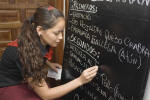Teaching reading: aims and approaches

There are two other guides to reading on this site and the following assumes you are familiar with the content of those. They are:
This guide recapitulates some of the information in the essential guide to teaching reading. It does not cover topics such as skimming, scanning, intensive and extensive reading skills so you will need to refer to that guide if the terms are unfamiliar to you or you would like to be reminded of what they really mean. It also assumes a fundamental knowledge of what reading skills are.
Almost all lessons require the learners to read at some point. Often, this reading is used to introduce some lexis, to kick-start a discussion or focus on a grammar point. However, reading skills in themselves should also be a central focus for a lesson or series of lessons.
 |
Using reading texts: TALO vs. TAVI vs. TASP |
TALO and TAVI are terms coined by Johns and Davies (1983) and mean:
- TALO: Text as a Linguistic Object
- In this approach, a reading text is used purely for language
input. It may contain, for example, grammatical items which
form the target of this part of the teaching programme or lexis in a
particular field of interest to the learners.
The approach involves mining the text for these language items (with most of the hard digging done by the teacher, usually) and then focusing on them for further clarification and practice. Examples of tasks using texts for this purpose will include activities such as:
Find and underline all the words in the text to do with crime and divide them into three lists: person who does the crime, the crime and the verb
Find all the ways in the text where the writer is recommending what should happen next. Make a list from strongest to weakest suggestions.
This is not using the text to develop reading skills, of course, except incidentally. - TAVI: Text as a Vehicle for Information
- In this approach, the text is being used to develop the
strategies that learners need to deploy to unlock the writer's
meanings and attitudes. The theory is that this approach will
lead to the development of cognitive strategies which learners can
then use independently to access the meaning of any text they
encounter.
Tasks typical of a TAVI approach to reading are, for example:
Is the writer strongly or only weakly opposed to tolls on main roads?
What does the writer say about his childhood in general? Did he have a normal childhood in your opinion?
It is a TAVI approach that is considered here because we are concerned with language skills rather than language systems development. - TASP: Text as a Springboard for Production
- Using texts in this third way may involve a good deal of TALO
use first because the text may be used as a model to analyse before
the learners embark on constructing their own texts following the
same generic staging and using similar circumstances and verbal
processes. Such a procedure would be typical of
a genre approach to
teaching writing skills.
This approach to reading texts may be much simpler, using the text purely as stimulus for discussion, role-play or a speaking activity. Texts are frequently used this way in conversation-driven classes typified by, e.g., Dogme.
Typical tasks in a TASP approach might be, for example:
Circle the paragraphs which set the scene of the story. Put a box around the complication in the story.
Underline the verbs phrases which refer to actions and highlight the verbs which refer to relationships.
Make a note of the three reasons the writer dislikes piped music. How far do you agree? Talk to your group to see how much agreement there is.
 |
The aims of a reading programme
Before we go on, can you make a note of what you believe should be the
target of a reading programme in terms of enabling our learners? |
The aims of a reading programme are to enable our learners to read:
- authentic texts
- without help
- at appropriate speed
- silently
- and with adequate understanding
We can take these five aims and break them down a little.
 |
authentic texts |
The first aim of the teaching programme is to allow learners
access to authentic texts.
There are two kinds of authenticity to consider:
- Text authenticity
- It is quite arguable that once a text has been brought into
a classroom and presented to learners in some way, its
authenticity has been compromised because it is not being used
for its original purpose.
Teachers may decide to highlight parts of the text for language analysis (TALO) and this means that authenticity is reduced.
Teachers may decide to alter or shorten a text to make it more accessible in terms of meaning (TAVI) and this, too, reduces its authenticity.
Teachers may decide to focus only on parts of the text which serve as models of the staging of information (TASP) and leave out portions so this, too, reduces authenticity.
Any authentic text which has been tampered with will no longer be authentic. - Learner authenticity
- This refers to the use that the learners are putting the
text to. For example, a travel brochure is written to
inform and persuade prospective customers of the advantages of a
particular holiday destination. Once it has been brought
into the classroom it could be used
to identify positive adjectival phrases (TALO)
as way of practising scanning and skimming skills (TAVI)
as a model text for learners to write their own texts about somewhere they know well (TASP)
All of these mean, of course, that the use to which the text is put is no longer authentic because the readers are not the writer's intended audience and are not reading for the same reasons.
(For more on authenticity and some discussion of authentic, quasi-authentic, semi-authentic and contrived materials, see the guide to authenticity.)
The aim of a reading programme will consider both types of authenticity but it need not do so from the outset.
 |
Grading the task |
The lower the level of learner, the more difficult it is to use
authentic materials, of course, but grading the task rather than
grading the text can be a productive approach. It does,
however, mean that learner authenticity is considerably reduced.
For example:
- Asking A1/A2-level learners to scan a local newspaper to find an advertisement for a restaurant and then identify (with a dictionary if it helps) what kind of food it serves is an example of a simple task being set for a complex text. This information can then be passed on to the rest of the class in terms of giving advice or information (making it both a TAVI and a TASP event).
- Getting B1/B2-level students to read a Wikipedia article presenting a biography of a famous person and draw a time line of just the most important dates and events is a way of developing the skill of scanning as well as raising awareness of the need to ignore some of a text.
- Getting C1/C2-level learners to read a short story and then summarise only the location, main characters, main events and eventual outcomes either as a speaking task or via something like a PowerPoint or poster presentation is a useful extensive reading task which does not require 100% understanding of the text itself.
 |
Grading the text: removing blocks to comprehension |
Grading the text, and thereby reducing its text authenticity, is the other obvious route. Here's an example (from Wikipedia) of a section of a text with the possible blocking items highlighted:
 |
Presley was born in Tupelo, Mississippi, and relocated to Memphis, Tennessee with his family when he was 13 years old. His music career began there in 1954, when he recorded a song with producer Sam Phillips at Sun Records. Accompanied by guitarist Scotty Moore and bassist Bill Black, Presley was an early popularizer of rockabilly. |
Note that rockabilly is not a blocking item here because Presley's music is well known and the class should know what it sounds like. If they don't, why are you using this article?
If an otherwise authentic text is made inaccessible to the learners because of one or two grammatical or lexical items, the problem can be dealt with in three ways:
- Glossing the items in the text with a footnote or inserted
comment
In the example above this would mean explaining the three blockers in a footnote as, e.g.:- relocate (v.): to move your home or a business to a different place (e.g., they are relocating my office to the fifth floor)
- accompany (v.): to go with someone or something (e.g., she accompanied him to the bus station and said goodbye there)
- popularizer: (n.): a person who makes something well known and liked (e.g., David Beckham was a popularizer of football in the USA)
- Pre-teaching the blocking items
In the example above, this will mean:- relocate: focus on the stem (locate) and use a synonym such as put in a place, elicit the meaning of the prefix re- and then supplying and eliciting examples as above.
- accompany: miming being arm-in-arm with someone and then eliciting / supplying examples such as the food is accompanied by a salad, the violinist was accompanied by a pianist, I accompanied the old lady across the street etc.
- popularizer: again, word formation, this time suffixation with -ize/-ise (to form the verb from the adjective) and -(e)r (to form the doer from the verb), is the focus once a synonym such as liked by lots of people has been provided for the adjective popular. Then you can elicit anyone else they know who popularised something.
- Replacing the blocking items with simpler alternatives.
This often produces an unnatural text because synonymy
is not complete. (The dangers of using synonymy to explain
lexis are covered in
the guide to synonymy.)
In this example, they could be:- relocated = moved
- accompanied by = playing together with
- popularizer = person who makes something well known and liked
A fourth alternative is to allow dictionary use, whether of
mono-lingual or bi-lingual sources. This can be effective but
learners need to be trained in their use or they may start looking up
words which are unnecessary for comprehension such as producer
in our example.
The focus on blocking items only needs to be maintained.
 |
without help |
The degree of independence which can be encouraged is also,
rather obviously, level dependent to a great extent.
Tactics such as task grading and text grading (above) may encourage
a feeling of independence in the classroom but true
independence in reading occurs outside the classroom.
Much depends on the purposes the learners have for
exercising reading skills.
 |
level 1: survival skills |
Many learners do not need sophisticated reading skills either
because their need for them is limited to surviving in an
English-speaking environment or because they will rarely need to
access complex written texts.
For these learners, a focus on notices, directories, public
information signs and so on is probably adequate. Such reading
texts can be almost wholly authentic and might include:
- timetables (all available online or in the environment)
- buses
- trains
- airlines
- menus (often available online or posted to people)
- on the wall: today's specials etc.
- in folders: starters, mains, desserts etc.
- for takeaway food: portion sizes, inclusions etc.
- prohibition notices (fishing, swimming, photography, ball games
etc.)
- No +
- It is forbidden to ...
- X forbidden
- direction signs
- exits
- information
- facilities
- basic informational texts detailing opening hours etc.
- museums
- shops
- recreation areas
- retail notices
- sales: discounts etc.
- prices: per kilo, pound, yard, metre etc.
- offers: multiple purchase offers, buy two get one free
- advertisements
- major companies (on line and in the press)
- small ads and announcements (notice boards in institutions, online local newspapers)
Texts like these require 100% comprehension but that is achievable
because they are almost always short and often accompanied by images.
Here's a small selection:
 |
 |
 |
 |
 |
 |
 |
 |
 |
 |
 |
 |
Thousands more of such things are available on the web.
 |
level 2: a measure of integration |
Many learners need slightly more advanced reading skills to attain a
measure of independence in social and professional contexts while not
needing hugely sophisticated reading skills.
For such learners, the following might be a short list of what's
required and, therefore, what should be included in a reading skills
programme:
- the press (skimming and intensive reading)
- social media (scanning and intensive reading)
- professional emails, memos, notes etc. (scanning and intensive reading)
- magazines and other print media (skimming and extensive / intensive reading)
- educational texts (skimming, scanning and intensive reading)
People vary widely and so do the settings in which they function so
this list can never be complete.
Only by investigating the needs of learners can we hope to meet their
aims and supply them with the strategies they need and familiarity with
the text types they are going to encounter and need to access.
 |
level 3: full independence |
Some learners need to function fully
independently in terms of reading skills.
These learners will need to:
- master the whole range of reading strategies:
- intensive reading
- extensive reading
- scanning
- skimming
- select the strategies which are appropriate for their purposes and the text type
- integrate the strategies appropriately
- be familiar with a very wide range of text types and genres
- attain a level of knowledge of structure and lexis which allows easy access to texts
This is not an easy set of targets but equipping learners with the fundamental skills is a step along the path to full independence (providing, of course, that that is where they need to be).
 |
at appropriate speed |
Increasing reading speed is often seen as a kind of Holy Grail of a
reading programme and there is little doubt that reading quite quickly
is a useful skill.
It is, however, often overemphasised at the expense of reading for
adequate comprehension. There's nothing wrong with reading quite
slowly if you have plenty of time and want to understand as much as you
can.
That said, as Nuttall (1996:127) has pointed out, there is a vicious circle at
work in which poor readers slow their reading rates to try to understand
every word and then become
frustrated and demotivated to read because it takes so long, so they
stop seeking out opportunities to read.
A number of factors slow readers down: blockage by unknown lexis,
complex structural phenomena and so on.
A major factor is applying the wrong strategy altogether, e.g., reading
intensively when one should be skimming or scanning. The solution
to this problem lies in better skills training with respect to
recognising and implementing the appropriate strategy (or combination of
strategies) to deal with a particular text for a particular purpose.
For that, see above.
 |
Word recognition skills |
If you have followed the first guide to what reading skills are, you
will recall that a reading speed of 200 words per minute is the minimum
which is considered adequate to understand both the sense of the words
and the connections between them. To attain speeds like these one
has to be able to recognise words on sight rather than laboriously
decoding them letter by letter or even syllable by syllable.
Sight recognition is, then, a vital preliminary skill which underlies
all other reading skills. It cannot be assumed; it must be taught.
Especially at the early stages of language learning, there are number
of exercises which can be used and they are especially suited to
computerised exercises (but needn't be done that way with some
imaginative use of a data projector or a simple paper-based procedure).
Here are some examples:
For single words:
| As quickly as you can underline the word that is the same. The first one is an example: | |||||
| time | tame | time | tome | tine | tune |
| arrive | arrange | arraign | arrive | arrow | arrest |
| break | broke | brake | bread | breath | break |
| agree | aggress | agile | agony | agree | egress |
For phrases:
| As quickly as you can underline this phrase: make the beds. The first one is an example: | ||||
| make the money | make the beds | make the bed | make the bread | bake the bread |
| take the beds | rake the bed | make a bed | take the beds | make a friend |
| make amends | shake the ends | make the beds | get a bed | make the beds |
| get the beds | make the beds | take the bread | make some beds | hate the bread |
Learners can, of course, do exercises like this for themselves and
even make them up for their peers in the class. Done frequently
enough and with as many variations as possible, reading speeds can be
quite dramatically increased.
If you would like to try an online test like this for whole short
sentences click here. Be
prepared to start immediately – you have only two minutes for
eight sentences.
A section of the part of this site for learners contains some more
exercises to help learners increase their reading speed and improve
their recognition skills. Click
here to go there (new tab or window).
 |
stepping up the pace |
This activity requires an appropriately long text and works like this:
- Give the learners the text and require them to read as much as possible in 60 seconds, starting at the beginning.
- Now give them another 60 seconds, again starting at the beginning, to read what they have already seen and go on.
- Repeat a third and fourth time.
The outcome should be that familiar material is read more quickly each time and learners begin to acquire the skill of skimming over what they are familiar with and moving on to the less familiar.
 |
repeat reading |
This is simple exercise:
- Get the learners to read, say, a 100-word paragraph and understand as much as possible. Time them.
- Now get them to re-read the paragraph in, say, 75% of the time they took the first time.
- Repeat, reducing the time limit again.
In theory at least, this will alert the learners to the fact that reading a paragraph quickly twice is more effective than reading it slowly once.
 |
individual reading-speed targets |
A consensus view is that a reading speed of 200 words per minute with 70% comprehension is the minimum that is required to reach the basic native-speaker rate. Most learners of English fall well below that rate.
- Check the learners' current rate by giving them an appropriate text with a few, but not too many, blocks and allowing them 60 seconds to get as far through it as they can. At an average of 12 words per line, for example, reaching line 10 would imply a reading speed of 120 words per minute.
- Now suggest an attainable reading speed for this week of, say, 10% better than they have achieved.
- Require learners to practise, at home or in class, until they have achieved the target rate and test them again.
- Set the next target until the reading speed reaches 200 words per minute.
Because each individual in the class will, probably, have a different initial reading speed, this exercise allows for individualised progress because we are discussing percentage rather than absolute targets.
 |
silently |
This may seem an odd category to include in the targets of a reading
programme but there are good reasons for its appearance here.
Some learners, especially at lower levels, may be tempted to read aloud
because it seems to aid comprehension. It does, in fact, and it
has also been shown to aid memorisation and especially affects the
short-term memory store.
Vocalisation does, however, have a demonstrably adverse effect on
reading speed and comprehension because the effort of articulating each word
slows the reader and takes away
from the effort that can be devoted to comprehension.
Later, the same learners may no longer be audibly reading aloud but they
are subconsciously forming the sounds of what they read in their heads.
This is known as sub-vocalising and everyone does it to some extent,
especially when trying to memorise a word or other piece of information
in a text.
This is not an easy habit to eradicate. Without specialist
apparatus, with which few classrooms are equipped, it is virtually
impossible to detect sub-vocalisation at all.
Raising awareness of its existence and implementing some of the ideas
for increasing reading speed (above) can be a great help.
 |
with adequate understanding |
The key lies in the term 'adequate'.
For a sports report in a newspaper, 30% may be considered adequate
understanding but for the instructions for using a chain saw, anything
less than 100% comprehension is potentially dangerous.
There are some classroom strategies:
- To raise the learners' awareness of what is required and get
them away from a chase for the Holy Grail of 100% comprehension,
discuss explicitly what the learners understand by 'adequate' for a
range of texts and purposes such as:
- finding out the time and gate number for your flight (100%)
- reading a short detective story (60% will do)
- flipping through the local paper to see what catches your eye (20% is adequate)
- reading a summary handout of a lecture (80% is enough)
- finding out if an email is spam (10%?)
- reading most websites (70% will do, even for this one)
- Do not require 100% accuracy in comprehension tests. Even native speakers only average around 70% understanding in most circumstances.
- Make sure that any tasks you set concerning comprehension bear the 70% threshold in mind. Insert enough redundancy to allow the same information to be read in two places.
- Vary text types and reasons for reading as much as possible in a reading programme to alert the learners to what is required to be adequate understanding, bearing in mind text type and purpose.
- Set post-reading tasks which are appropriate to the amount of comprehension that is adequate for the purpose and text type. Requiring 100% comprehension of a sports report, for example, is unreasonable, inappropriate and unfair.
- Make sure you focus at some time on TAVI even if your ultimate goal is to use the text as a language resource (TALO) or a model (TASP).
If you want more in this area do the guide to inferencing which discusses reading and accessing meaning in some detail.
| Go to the in-service skills index |
References:
Johns, T. and Davies, F., 1983, Text as a
vehicle for information: the classroom use of written texts in teaching
reading in a foreign language, Reading in a Foreign Language 1/1:1-19.
Nuttall, C., 1996, Teaching reading skills in a foreign language,
Oxford: Heinemann English Language Teaching
References you may
also find helpful
include:
Alderson, J. C, 2000, Assessing Reading, Cambridge: Cambridge
University Press
Bamford, J & Day, RR (eds.), 2004, Extensive Reading Activities
for Teaching Language, Cambridge: Cambridge University Press
Grellet, F, 1981, Developing Reading Skills, Cambridge:
Cambridge University Press
Hudson, T, 2007, Teaching Second Language Reading, Oxford:
Oxford University Press
Sanderson, P, 1999, Using Newspapers in the Classroom,
Cambridge: Cambridge University Press
Urquhart, AH & Weir, CJ, 1998, Reading in a Second Language:
Process, Product, and Practice, Harlow: Longman
Wallace, C, 1992, Reading, Oxford: Oxford University Press
